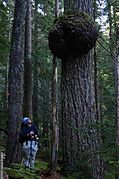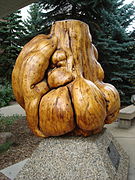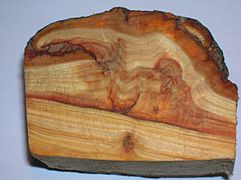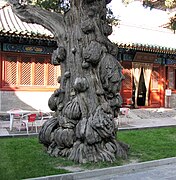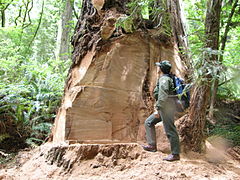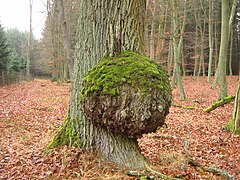Burl
This article includes a list of general references, but it lacks sufficient corresponding inline citations. (June 2011) |

A burl (American English) or burr (British English) is a tree growth in which the grain has grown in a deformed manner. It is commonly found in the form of a rounded outgrowth on a tree trunk or branch that is filled with small knots from dormant buds. Burl formation is typically a result of some form of stress such as an injury or a viral or fungal infection.
Burls yield a very peculiar and highly figured wood sought after in woodworking, and some items may reach high prices on the wood market. Poaching of burl specimens and damaging the trees in the process poses a problem in some areas.
Description
[edit]
A burl results from a tree undergoing some form of stress. It may be caused by an injury, virus or fungus.[1] Most burls grow beneath the ground, attached to the roots as a type of malignancy that is generally not discovered until the tree dies or falls over. Such burls sometimes appear as groups of bulbous protrusions connected by a system of rope-like roots. Almost all burl wood is covered by bark, even if it is underground. Insect infestation and certain types of mold infestation are the most common causes of this condition.
In some tree species, burls can grow to great size. The largest, at 26 ft (8 m), occur in coast redwoods (Sequoia sempervirens) and can engirdle the entire trunk; when moisture is present, these burls can grow new redwood trees. One of the world's largest burls can be found in Port McNeill, British Columbia.[2]
Use
[edit]
Burls yield a very peculiar and highly figured wood, prized for its beauty and rarity. It is sought after by furniture makers, artists, and wood sculptors. There are a number of well-known types of burls (each from a particular species); these are highly valued and sliced into veneers for furniture, inlay in doors, picture frames, household objects, automobile interior paneling and trim, musical instruments, and woodturning.
Working the Wood
[edit]The prized "burr maple" is not a species of a maple, but wood from a maple's burl (burr). The famous birdseye maple of the sugar maple (Acer saccharum) superficially resembles burr maple, but it is something else entirely. Burl wood is very hard to work with hand tools or on a lathe, because its grain is twisted and interlocked, causing it to chip and shatter unpredictably. This "wild grain" makes burl wood extremely dense and resistant to splitting, which made it valued for bowls, mallets, mauls and "beetles" or "beadles" for hammering chisels and driving wooden pegs.[3]
Poaching
[edit]Because of the value of burls, ancient redwoods in national parks in the Western United States have recently been poached by thieves for their burls, including at Redwood National and State Parks.[4] Poachers often cut off the burls from the sides of the trunks using chainsaws, which exposes the tree to infection and disease, or fell the entire tree to steal burls higher up.[4] Because of the risk of poaching, Jeff Denny, the state park's redwood coast sector supervisor, encourages those buying burl to inquire where it came from and to ensure it was obtained legally. Legal acquisition methods for burl include trees from private land cleared for new development and from lumber companies with salvage permits.[4]
Gallery
[edit]-
A bowl made from a plum tree burl
-
A giant burl near Solduc Falls in the Olympic National Park
-
A large spruce burl on display at the University of Alberta
-
A longitudinal section through a larch burl from Ayrshire, Scotland
-
Multiple burls on an ancient cypress tree at the Beijing Temple of Confucius in China
-
A park ranger inspects a redwood tree illegally cut to obtain a burl, Redwood National Park, California
-
Burls on Sitka spruces, Olympic National Park, Washington, US
-
Burl near Palfau,
in central Austria -
Burls Pithecellobium dulce
-
Burls on hollow trunk, Samanea saman
See also
[edit]References
[edit]- ^ "What's a "Burl" and Why Is There One on My Tree?". The Spruce. Retrieved 2024-05-13.
- ^ https://www.timescolonist.com/local-news/port-mcneill-moving-beloved-burl-to-new-more-visible-location-8226172
- ^ Sloane, Eric (1973). A Museum of Early American Tools. New York: Ballantine Books. pp. 28–32. ISBN 0-486-42560-6.
- ^ a b c Brown, Patricia Leigh (April 8, 2014). "Poachers Attack Beloved Elders of California, Its Redwoods". The New York Times.
Further reading
[edit]- Corbett, Stephen (2006). The Illustrated Professional Woodworker. London: Anness Publishing. ISBN 978-0-681-22891-7.
- Funk, A. (1982). "Therrya canker of spruce in British Columbia". Canadian Journal of Plant Pathology. 4 (4): 357–61. Bibcode:1982CaJPP...4..357F. doi:10.1080/07060668209501277.
- James, Susanne (1984). "Lignotubers and Burls: Their Structure, Function and Ecological Significance in Mediterranean Ecosystems". Botanical Review. 50 (3): 225–66. Bibcode:1984BotRv..50..225J. doi:10.1007/BF02862633. JSTOR 4354037. S2CID 20759935.
- Powers, Steven S. (2005). North American Burl Treen: Colonial & Native American. Brooklyn: S. Scott Powers Antiques. ISBN 978-0-9760635-0-6.
- Rankin, William Howard (1918). "Mistletoe Burl and Witches'-Broom". Manual of Tree Diseases. pp. 214–5. OCLC 1652501.
- White, PR; Millington, WF (February 1954). "The distribution and possible importance of a woody tumor on trees of the white spruce, Picea glauca". Cancer Research. 14 (2): 128–34. PMID 13126948.
- White, PR (April 1958). "A Tree Tumor of Unknown Origin". Proceedings of the National Academy of Sciences of the United States of America. 44 (4): 339–44. Bibcode:1958PNAS...44..339W. doi:10.1073/pnas.44.4.339. JSTOR 89803. PMC 335423. PMID 16590202.
- Zalasky, Harry (1975). "Low-temperature-induced cankers and burls in test conifers and hardwoods". Canadian Journal of Botany. 53 (21): 2526–35. doi:10.1139/b75-277.


